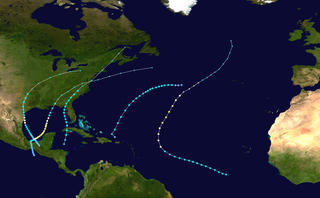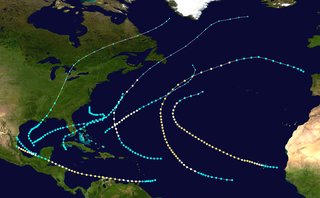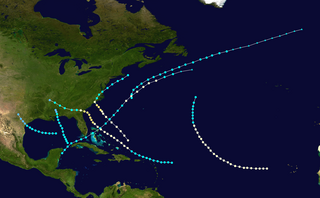
The 1930 Atlantic hurricane season was a very inactive Atlantic hurricane season. It was the second least active on record in terms of tropical storms forming, only behind 1914, with only three systems reaching tropical storm intensity. Of those three, two reached hurricane status, both of which also became major hurricanes, Category 3 or higher storms on the Saffir–Simpson hurricane wind scale. The first system developed in the central Atlantic Ocean on August 21. Later that month, a second storm, the Dominican Republic hurricane, formed on August 29. It peaked as a Category 4 hurricane with winds of 155 mph (250 km/h). The third and final storm dissipated on October 21.

The 1929 Atlantic hurricane season was a near average season in terms of accumulated cyclone energy, but is among the least active Atlantic hurricane seasons on record in terms of storms forming, with only five tropical cyclones forming. Three of them intensified into a hurricane, with one strengthening further into a major hurricane. The first tropical cyclone of the season developed in the Gulf of Mexico on June 27. Becoming a hurricane on June 28, the storm struck Texas, bringing strong winds to a large area. Three fatalities were reported, while damage was conservatively estimated at $675,000 (1929 USD).

The 1919 Atlantic hurricane season was among the least active hurricane seasons in the Atlantic on record, featuring only five tropical storms. Of those five tropical cyclones, two of them intensified into a hurricane, with one strengthening into a major hurricane Two tropical depressions developed in the month of June, both of which caused negligible damage. A tropical storm in July brought minor damage to Pensacola, Florida, but devastated a fleet of ships. Another two tropical depressions formed in August, the first of which brought rainfall to the Lesser Antilles.

The 1909 Atlantic hurricane season was an average Atlantic hurricane season. The season produced thirteen tropical cyclones, twelve of which became tropical storms; six became hurricanes, and four of those strengthened into major hurricanes. The season's first storm developed on June 15 while the last storm transitioned into an extratropical cyclone on November 14. The most notable storm during the season formed in late August, while east of the Lesser Antilles. The hurricane devastated the Lesser Antilles, the Greater Antilles, and Mexico, leaving around 4,000 fatalities and more than $50 million (1909 USD) in damage.

The 1904 Atlantic hurricane season featured no tropical cyclones during the months of July and August. The season's first cyclone was initially observed in the southwestern Caribbean on June 10. After this storm dissipated on June 14, the next was not detected until September 8. The sixth and final system transitioned into an extratropical cyclone offshore South Carolina on November 4. Two of the six tropical cyclones existed simultaneously.

The 1902 Atlantic hurricane season featured five known tropical cyclones, three of which made landfall in the United States. The first system was initially observed in the northwestern Caribbean on June 12. The last system dissipated on November 6 while located well southeast of Newfoundland. These dates fall within the period with the most tropical cyclone activity in the Atlantic. None of the systems existed simultaneously.

The 1899 Atlantic hurricane season featured the longest-lasting tropical cyclone in the Atlantic basin on record. There were nine tropical storms, of which five became hurricanes. Two of those strengthened into major hurricanes, which are Category 3 or higher on the modern day Saffir–Simpson scale. The first system was initially observed in the northeastern Gulf of Mexico on June 26. The tenth and final system dissipated near Bermuda on November 10. These dates fall within the period with the most tropical cyclone activity in the Atlantic. In post-season analysis, two tropical cyclones that existed in October were added to HURDAT – the official Atlantic hurricane database. At one point during the season, September 3 through the following day, a set of three tropical cyclones existed simultaneously.

The 1894 Atlantic hurricane season included four major hurricanes, one of the highest totals in the second half of the 19th century and behind only the previous year. Additionally, the season featured a total of seven tropical storms, five of which strengthened into a hurricane. However, in the absence of modern satellite and other remote-sensing technologies, only storms that affected populated land areas or encountered ships at sea were recorded, so the actual total could be higher. An undercount bias of zero to six tropical cyclones per year between 1851 and 1885 and zero to four per year between 1886 and 1910 has been estimated.

The 1893 Atlantic hurricane season featured the only known instance of more than one tropical cyclone causing at least 1,000 deaths in the United States. It was a fairly active season, with 12 tropical storms forming, 10 of which became hurricanes. Of those, five became major hurricanes. The season is considered hyper-active in terms of accumulated cyclone energy, achieving a total of 231 units, which remains the third-highest ever recorded in the Atlantic basin. Additionally, 1893 became one of two seasons on record to see four Atlantic hurricanes active simultaneously, along with 1998. In the absence of modern satellite and other remote-sensing technologies, only storms that affected populated land areas or encountered ships at sea were recorded, so the actual total could be higher. An undercount bias of zero to six tropical cyclones per year between 1851 and 1885 and zero to four per year between 1886 and 1910 has been estimated. The first system was initially observed on June 12 in the Bay of Campeche, while the twelfth and final storm transitioned into an extratropical cyclone on November 9 over the northwestern Atlantic.

The 1890 Atlantic hurricane season was among the least active Atlantic hurricane seasons on record. The first tropical cyclone of the season was initially observed on May 27 and the last storm, Hurricane Four, dissipated over Central America on November 1. These dates fall within the period with the most tropical cyclone activity in the Atlantic. The first storm moved slowly north-northwestward, bringing heavy rains and extensive flooding to Cuba, which caused at least three fatalities and at least $1 million (1890 USD) in damage. It dissipated in the Gulf of Mexico on May 29. Tropical cyclogenesis went dormant for nearly two and a half months, until another system was observed near the Windward Islands on August 18. It traversed the Caribbean Sea and Gulf of Mexico, grazing the Yucatan Peninsula and making landfall in Louisiana before dissipating on August 28. Impact from the storm was minimal.

The 1892 Atlantic hurricane season included the last tropical cyclone on record to pass through the Cabo Verde Islands at hurricane intensity until 2015. A total of nine tropical storms developed, five of which strengthened into a hurricane, though none of them became a major hurricane. However, in the absence of modern satellite and other remote-sensing technologies, only storms that affected populated land areas or encountered ships at sea were recorded, so the actual total could be higher. An undercount bias of zero to six tropical cyclones per year between 1851 and 1885 and zero to four per year between 1886 and 1910 has been estimated. Three tropical storms made landfall on the United States.

The 1880 Atlantic hurricane season ran through the summer and fall of 1880. This is the period of each year when most tropical cyclones form in the Atlantic basin. In the 1880 Atlantic season there were two tropical storms, seven hurricanes, and two major hurricanes (Category 3+). However, in the absence of modern satellite and other remote-sensing technologies, only storms that affected populated land areas or encountered ships at sea were recorded, so the actual total could be higher. An undercount bias of zero to six tropical cyclones per year between 1851 and 1885 and zero to four per year between 1886 and 1910 has been estimated. Of the known 1880 cyclones, Hurricane Six was first documented in 1995 by José Fernández-Partagás and Henry Díaz. They also proposed large changes to the known tracks of several other storms for this year and 're-instated' Hurricane Ten to the database. A preliminary reanalysis by Michael Chenoweth, published in 2014, found thirteen storms, nine hurricanes, and four major hurricanes.

The 1885 Atlantic hurricane season ran through the summer and the first half of fall in 1885. This is the period of each year when most tropical cyclones form in the Atlantic basin. In 1885 there were two tropical storms and six hurricanes in the Atlantic basin. However, in the absence of modern satellite monitoring and remote-sensing technologies, only storms that affected populated land areas or encountered ships at sea were recorded, so the actual total could be higher. An undercount bias of zero to six tropical cyclones per year between 1851 and 1885 and zero to four per year between 1886 and 1910 has been estimated.

The 1881 Atlantic hurricane season featured a tropical cyclone that remains one of the deadliest in the history of the United States. Seven tropical storms are known to have developed, four of which strengthened into hurricanes, though none of those intensified into a major hurricane. However, in the absence of modern satellite and other remote-sensing technologies, only storms that affected populated land areas or encountered ships at sea were recorded, so the actual total could be higher. An undercount bias of zero to six tropical cyclones per year between 1851 and 1885 and zero to four per year between 1886 and 1910 has been estimated.

The 1882 Atlantic hurricane season ran through the summer and early fall of 1882. This is the period of each year when most tropical cyclones form in the Atlantic basin. In the 1882 Atlantic season there were two tropical storms, two Category 1 hurricanes, and two major hurricanes. However, in the absence of modern satellite and other remote-sensing technologies, only storms that affected populated land areas or encountered ships at sea were recorded, so the actual total could be higher. An undercount bias of zero to six tropical cyclones per year between 1851 and 1885 and zero to four per year between 1886 and 1910 has been estimated. Of the known 1882 cyclones, Hurricane One and Hurricane Five were both first documented in 1996 by Jose Fernandez-Partagas and Henry Diaz, while Tropical Storm Three was first recognized in 1997 and added to HURDAT in 2003. Partagas and Diaz also proposed large changes to the known track of Hurricane Two while further re-analysis, in 2000, led to the peak strengths of both Hurricane Two and Hurricane Six being increased. In 2011 the third storm of the year was downgraded from a hurricane to a tropical storm.

The 1854 Atlantic hurricane season featured five known tropical cyclones, three of which made landfall in the United States. At one time, another was believed to have existed near Galveston, Texas, in September. However, HURDAT – the official Atlantic hurricane database – now excludes this system. The first system, Hurricane One, was initially observed on June 25. The final storm, Hurricane Five, was last observed on October 22. These dates fall within the period with the most tropical cyclone activity in the Atlantic. No tropical cyclones during this season existed simultaneously. One tropical cyclone has a single known point in its track due to a sparsity of data.

The 1875 Atlantic hurricane season featured three landfalling tropical cyclones. However, in the absence of modern satellite and other remote-sensing technologies, only storms that affected populated land areas or encountered ships at sea were recorded, so the actual total could be higher. An undercount bias of zero to six tropical cyclones per year between 1851 and 1885 has been estimated. There were five recorded hurricanes and one major hurricane – Category 3 or higher on the modern-day Saffir–Simpson scale.

The 1871 Atlantic hurricane season lasted from mid-summer to late-fall. Records show that 1871 featured two tropical storms, four hurricanes and two major hurricanes. However, in the absence of modern satellite and other remote-sensing technologies, only storms that affected populated land areas or encountered ships at sea were recorded, so the actual total could be higher. According to a study in 2004, an undercount bias of zero to six tropical cyclones per year between 1851 and 1885 and zero to four per year between 1886 and 1910 is possible. A later study in 2008 estimated that eight or more storms may have been missed prior to 1878.

The 1863 Atlantic hurricane season featured five landfalling tropical cyclones. In the absence of modern satellite and other remote-sensing technologies, only storms that affected populated land areas or encountered ships at sea were recorded, so the actual total could be higher. An undercount bias of zero to six tropical cyclones per year between 1851 and 1885 has been estimated. There were seven recorded hurricanes and no major hurricanes, which are Category 3 or higher on the modern day Saffir–Simpson scale. Of the known 1863 cyclones, seven were first documented in 1995 by José Fernández-Partagás and Henry Diaz, while the ninth tropical storm was first documented in 2003. These changes were largely adopted by the National Oceanic and Atmospheric Administration's Atlantic hurricane reanalysis in their updates to the Atlantic hurricane database (HURDAT), with some adjustments.

The 1858 Atlantic hurricane season was one of only three Atlantic hurricane seasons on record in which every tropical cyclone intensified into a hurricane. The first hurricane was first observed over the northwestern Caribbean Sea on June 12. The sixth and final storm was last noted on October 26. These dates fall within the period with the most tropical cyclone activity in the Atlantic. Three tropical cyclones during the season existed simultaneously. Two of the cyclones have only a single known point in its track due to a sparsity of data. Operationally, another tropical cyclone was believed to have existed over the eastern Atlantic between September 17 and September 18, but HURDAT – the official Atlantic hurricane database – excludes this system. However, in the absence of modern satellite and other remote-sensing technologies, only cyclones that affected populated land areas or encountered ships at sea are currently known, so the actual total could be higher. An undercount bias of zero to four tropical cyclones per year between 1886 and 1910 has been estimated. Of the six known 1858 Atlantic cyclones, five were first documented in 1995 by Jose Fernandez-Partagas and Henry Diaz.

























